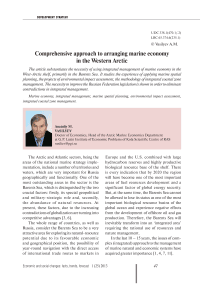Comprehensive approach to arranging marine economy in the western arctic
Автор: Vasilyev Anatoliy Mikhailovich
Журнал: Economic and Social Changes: Facts, Trends, Forecast @volnc-esc-en
Рубрика: Development strategy
Статья в выпуске: 1 (25) т.6, 2013 года.
Бесплатный доступ
The article substantiates the necessity of using integrated management of marine economy in the West-Arctic shelf, primarily in the Barents Sea. It studies the experience of applying marine spatial planning, the projects of environmental impact assessment, the methodology of integrated coastal zone management. The necessity to improve the Russian Federation legislation is shown in order to eliminate contradictions in integrated management.
Marine economy, integrated management, marine spatial planning, environmental impact assessment, integrated coastal zone management
Короткий адрес: https://sciup.org/147223436
IDR: 147223436 | УДК: 338.1(470.1/.2)
Текст научной статьи Comprehensive approach to arranging marine economy in the western arctic
The Arctic and Atlantic sectors, being the areas of the national marine strategy implementation, include a number of territories and waters, which are very important for Russia geographically and functionally. One of the most outstanding areas in the sector is the Barents Sea, which is distinguished by the two crucial factors: firstly, its special geopolitical and military-strategic role and, secondly, the abundance of natural resources. At present, these factors, due to the increasing contradictions of globalization are turning into competitive advantages [3, 6].
The whole range of countries, as well as Russia, consider the Barents Sea to be a very attractive area for exploring its natural-resource potential due to its favourable economic and geographical position, the possibility of year-round navigation with the direct access of international trade routes to markets in
Europe and the U.S. combined with large hydrocarbon reserves and highly productive biological resource base of the shelf. There is every indication that by 2020 the region will have become one of the most important areas of fuel resources development and a significant factor of global energy security. But, at the same time, the Barents Sea cannot be allowed to lose its status as one of the most important biological resource basins of the global ocean and experience negative effects from the development of offshore oil and gas production. Therefore, the Barents Sea will inevitably transform into an ‘integrated area’ requiring the rational use of resources and nature management.
In the last 10 – 15 years, the issues of complex (integrated) approach to the management of marine natural and economic systems have acquired greater importance [1, 4, 7, 11].
It is conditioned by the inefficiency of the branch-wise and departmental approaches to management, which causes tensions between the users of natural resources and the increasing anthropogenic threats to marine ecosystems in the areas of intensive economic activity. Developed countries have been recently using marine spatial planning (MSP) based on the ecosystem approach to the marine activities planning and management as the main tool for the implementation of marine policy. The Study of MSP methodology shows that its goal is to create conditions for the efficient coexistence of various industries, in particular: fishery, oil and gas activities and maritime transport. MSP should promote the elaboration of a common stand in the management of the considered marine area among the representatives of various industries, local, regional and central authorities, as well as among nature conservation organizations and groups representing other interests, in the framework of sustainable development.
Marine spatial planning is currently a tool of integrated coastal zone management (ICZM) and the implementation of marine policy. It promotes the system and long-term use of the marine environment through a more rational and efficient organization of maritime space, the regulation of interaction between its different users, as well as by ensuring the balanced development of marine activities and protection of marine environment.
MSP is a way to improve the efficiency of decision-making on the issues of organizing human activities in marine environment, based on ecosystem approach. It provides an opportunity for a complex, long-term and consistent regulation of marine space utilization. The purpose of marine spatial planning consists in promoting a more rational usage of marine space and interaction between utilization types; furthermore, MSP should bring the development requirements in accordance with environmental protection and contribute to the achievement of social and economic objectives through planning and open discussions. Marine spatial planning, being an efficient method of functional zoning and strategic assessment of marine areas utilization opportunities, despite certain application limitations caused by the current absence of relevant legislation, can become a useful tool in the development of coastal marine component of the strategies and comprehensive programmes on the socioeconomic development of coastal territories.
The development of marine spatial planning is one of the promising directions for enhancing the marine activities management system, and it is stated in the Strategy for the development of marine activity of the Russian Federation up to 2030 [9].
The Integrated Management Plan for the Barents Sea, elaborated by Norway in 2002 – 2006 is a successful example of the world experience in marine activity management in the Arctic Region. The plan is chiefly aimed at creating favourable conditions for sustainable exploitation of the Barents Sea resources, the development of transport and other production activities, maintaining at the same time the structure, functions and productivity of existing ecosystems. Other examples include the Eastern Scotian Shelf Integrated Management Plan (Canada, 1998 – 2007), the Irish Sea Pilot Project (Great Britain, 2002 – present), the General Plan for the Belgian part of the North Sea (Belgium, 2003 – 2005) the Integrated Management Plan for the North Sea, 2003 – present), the Spatial Plan for the North Sea and Baltic Sea, 2004 – present) [10].
Economic activity within individual seas (transport, fishery, oil and gas extraction, etc.) does not form a unified system and it is not aimed at obtaining the integrated useful result. Such concepts as ‘fish industry’, ‘ship repair complex’, ‘oil and gas complex’, etc. illustrate the fact. A single marine complex on a national or regional scale is formed only with the enhancement of rational interrelations and the achievement of the optimal combination of major marine and coastal economic sectors. First of all, these processes involve integrated marine areas.
Thus, marine and coastal ecosystems in the Global Ocean serve as the basis for ‘planning and management units’, and sectoral marine complexes – as their superstructure. These components are united most adequately in the concept ‘regional marine economic complex’ (RMEC), which is a form of unification of nature, economy and society.
The internal spatial relationships between the various users of natural resources in the Barents Sea has just recently started to develop, reflecting the initial development stage of a new, more complex ecological-economic situation, and subsequently, a new ecological-economic system. Until recently, the absence of competitors to the fishing industry contributed to the formation of psychological monopoly on the use of natural resources in this region. At present, the shelf resources are developed by various economic sectors, and the integrated management of versatile marine activities can become a tool for ensuring sustainable development [8].
Traditionally the Northern sea areas and the Barents Sea were used mainly for fishing and sea transportations. Nowadays, the situation is changing significantly. Oil and gas production, coastal transportations of oil (effective – to the West and developing – to the East), the increasing number of ships cruising along the coasts and in the marine areas of the Arctic, as well as the exploration of marine bioresources are the new types of activities that require assessment of interests, coordination and regulation with regard to the traditional types of activity. It concerns especially the relationship between oil industry and fishing industry, between sea transport and fishing industry and between transport and gas industry.
The need for an efficient inter-sectoral marine management system is intensified by certain changes in economic structure. In terms of creating economic values, the Barents region and its neighbouring seas have a great potential.
Among the wide range of approaches to the development of management systems, a comprehensive or an integrated one is the most efficient, as it was stated above [6, 7, 12]. The concept of integrated approach includes four essential components:
-
• firstly, the connections between all the major ecosystem components within the selected water area, water layer, bottom and shores (abiotic and biotic);
-
• secondly, management should be planned and implemented in the context of a longterm development strategy;
-
• thirdly, the relations between the different users of nature and their social and environmental interests and values should be considered together;
-
• fourthly, the territorial contradictions of nature management should be resolved by transforming corporate interests into national ones in order to achieve strategic compromise.
In Russia the development of conceptual framework and methodology in this area is only in its initial stage. In this connection, the notions of an ecosystem approach to the development of MSP seem very promising. The MSP formation mechanism may include the following succession of actions: study of the initial state of a marine object and its analysis from economic view points → forecasting of anthropogenic changes of a system according to the planned economic activity → choice of methods and measures for the minimization of negative consequences. This sequence corresponds to the development methodology of the Environmental Impact Assessment (EIA) projects. However, in this case, EIA should be applied not only to individual projects, but also to the areas of operation of individual industries with the subsequent coverage of the whole managed water area.
In case of the Barents sea, shifting from the assessments of environmental effects of a certain industry (e.g. oil and gas industry) to functional assessments makes it possible to abandon the ‘opposing’ EIA procedures (e.g. fishing against oil and gas production) and move to strategic, territorial ones, i.e. to create the analytical and forecast basis of marine spatial planning.
Multiple-use marine areas often suffer from the competition for exploitation of the bottom, shores and water areas. In particular, such industries as fishery and oil and gas production are potential competitors for the space of almost entire basin of the Barents Sea. Figure 1 shows the location of fishing areas and prospective oil and gas facilities in the Barents Sea. A number of potentially disputed areas are defined, for instance, the structures of the Murmanskoye and Severo-Kildinskoye deposits, where the share of the average catch of fish is relatively high. As for the Barents sea, such competition is not critical yet, however, in the future it may become alarming.
Competition for one’s ‘share’ in marine areas is quite tough. However, along with the development of technology, the direct management area will encompass the sea and ocean areas more distant from the land (for example, oil and gas extraction on the continental slopes), thereby increasing the scale of managed subsystem and expanding the zones of potential conflicts.
The Marine Activity Development Strategy of the Russian Federation up to 2030 (approved by the RF Government Order dated December 8, 2010 No. 2205-r) stipulates as its strategic objective ‘the transition to an integrated approach to the planning of the development of marine and coastal areas of specific coasts of the country by uniting them into a single object of state management’.
The number of coastal subjects of the Russian Federation, implementing or drafting such programmes should be 21. Marine natural resources management, according to the strategy, should be developed as follows:
– ‘introduction and development of the integrated (inter-sectoral) management at all levels that considers maritime economy as an integrated management object and is aimed at preserving the marine environment and eliminating the conflicts emerging from the multiple use of marine areas;
– expansion of the marine component of the programmes on the comprehensive development of coastal territories and coastal marine areas to the borders of the sea areas under the RF jurisdiction;
– utilization and development of marine spatial planning tools’.
It should be noted that it is, perhaps, the first time a federal document raises the issue concerning the necessity of an integrated planning and management of maritime economy. The stated objectives and tasks are expected to be achieved mainly by implementing individual sectoral programmes under the RF Government coordination.
Consideration of coastal territories and coastal water areas as a single object of state management is aimed at improving the regional strategic socio-economic planning and it will promote the development of mechanisms for vertical and horizontal integration of strategies and development programmes. This will make it possible to harmonize the interests of the federal centre and regions, individual users, optimize the structure and enhance the efficiency of state support to the coastal zone development.
Integrated coastal zone management (ICZM) is the most widespread and approved integrated management model in the world practice of nature management. ICZM methodology is aimed at creating an efficient economic structure of coastal marine areas, at
Figure 1. Natural resource management system of the Barents Sea (the object of management) [8]
0° 20° Е 40° Е 60° Е 80° Е
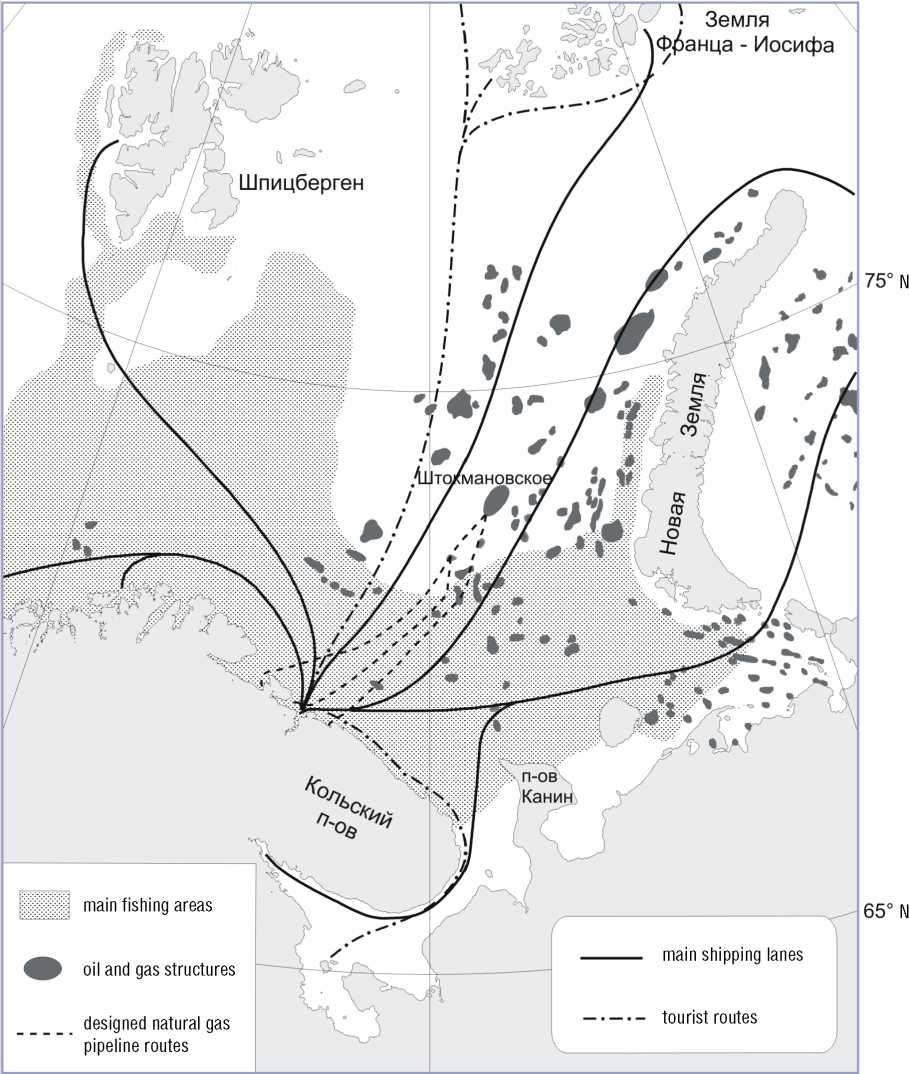
enhancing the efficiency of marine and coastal economy by resolving the disputes over the competitive utilization of marine and coastal resources, at improving the organization opportunities and human potential development. According to the Ministry of Economic Development, regional strategies and programmes on the socio-economic development of all the coastal subjects of the Russian Federation and their coastal municipalities should contain a separate section representing the coastal and marine component, aimed at promoting innovations and achieving cooperation through the coordinated development of marine activity and its coastal infrastructure.
The structure and content of the coastal and marine component of development strategies and programmes of various levels should complement each other, thus creating a common system of strategic planning.
The project of the ‘Methodological guide for the development of the coastal and marine component...’ (not published) envisages a three-level structure (fig. 2) .
In our viewpoint, the zone at the municipal level should comprise the territory of the municipality and the territorial sea within the zone boundaries, which will provide opportunities for the development of coastal industrial fishery and fishing for private use.
Figure 2. Basic scheme of a three-level vertical structure of ICZM with indication of the land boundaries of the coastal areas and maritime borders of the coastal areas, corresponding to the various levels of state administration
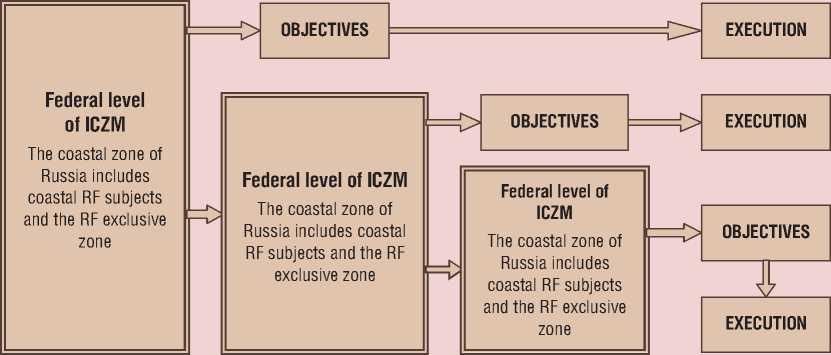
The cluster approach is a tool that promotes the transition from sectoral to integrated management. This approach combines cross-sectoral and territorial principles, allows taking into account internal and external trends and changes in the structure of the main production factors, provides an integrated approach to the planning of the socio-economic development of coastal territories. Maritime activities, which represent the system of interaction between the different types of activities and which have a significant multiplicative effect, are a promising object for the use of cluster approach.
The cluster approach actually changes the content of the state industrial policy. In this case, the efforts of government authorities should be directed toward the development of the relations between suppliers and consumers, between ultimate consumers and producers, between producers and government institutions rather than toward the support of individual enterprises and industries.
Today, the existing and planned activities in the Murmansk coastal zone are concentrated in the nominal triangle with vertices in the areas of Varangerfjord, Pechenga Bay – Murmansk city, Kola Bay – Teriberka rural locality,
Orlovka Bay, Korabelnaya Bay, Zavalishina Bay, Lodeynaya Bay, Opasova Bay (fig. 3) [2].
It is this relatively small (about 5.3 thousand square km) area of the Kola Peninsula where the planning, exploration and construction activities are carried out in the framework of the two federal megaprojects: the coastal infrastructure of the Shtokman project and the infrastructure of the Murmansk transportation hub. The naval, frontier and EMERCOM forces are stationed here, and this area possesses huge potential for coastal fishing, aquaculture and recreation.
The population in the Murmansk coastal zone is distributed rather unevenly, its vast majority is concentrated within the Kola Bay shores (up to 90%). According to the available statistical data, the contribution of the coastal zone in the Murmansk Oblast economy is still very small (not more than 15%). This does not correspond to the potential of the Murmansk coastal zone, and hampers the transition of the whole peninsular region to sustainable development.
Coastal fishing and processing of hydrobionts are the socially significant activities in the coastal zone of the Kola Peninsula.
Figure 3. The Murmansk coastal zone
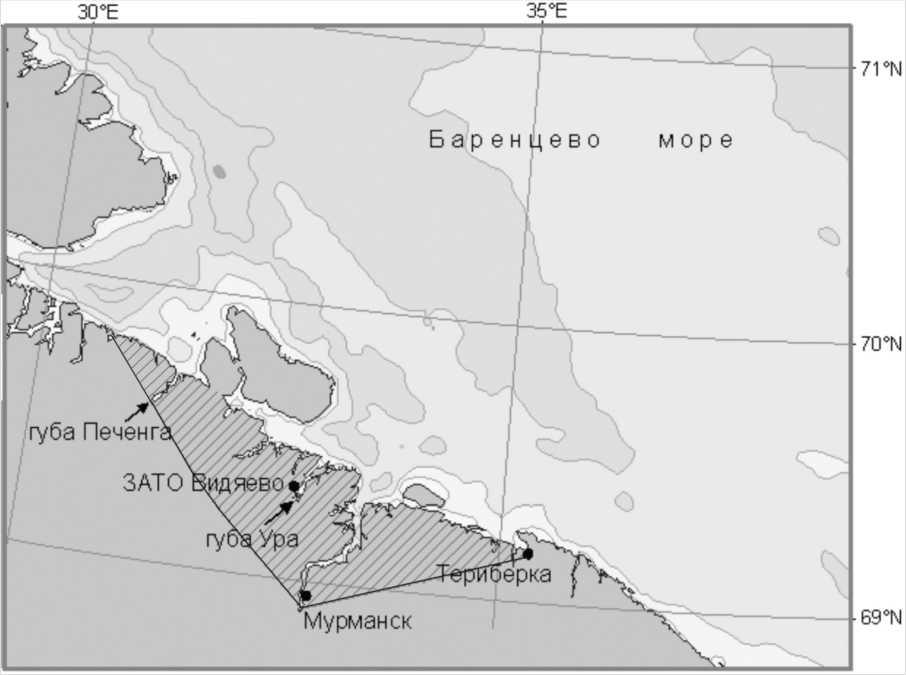
These activities can promote the settlement of population in the coastal areas, ensure their employment and improve their living standards, enhance the fiscal capacity of local municipalities.
At present, the coastal zone, traditionally exploited by fishermen, is considered (and partially used) as an integral spatial resource for any marine activity, whether fishing, aqua-culture, marine transportation, specially protected areas, defense or recreation. Such a diversity of activities on one and the same territory (water area) cannot but cause disputes and conflicts. Figure 4 shows the interaction between various types of activities in the open sea and coastal areas, as well as the classification of possible conflicts between users of nature [13]. The analysis of the matrix shows that, in practice, the most typical are numerous and frequent conflicts (over 50%). Individual (pair) conflicts are 2 times less frequent, and peaceful interactions almost never happen.
Figure 3 shows the so-called ‘hot spots’ in the triangle of intensive anthropogenic activity that emphasize the necessity of creating ICZM programmes approved at the high level for these natural and anthropogenic sites.
In the first place, it will be necessary to substantiate the priority development directions of the coastal areas of the Kola Peninsula based on the region’s sustainable development concept, i.e. the triad of economy, social issues and environment. The inclusion of the coastal and marine component into the strategy and programmes on the socio-economic development of coastal areas should be aimed at ensuring the balance between the short-term economic benefits and the achievement of longterm development goals. This requires, first of all, identifying the factors restricting the use of coastal zones, including legislative and normative documents. Back in 1998 the concept of ‘administrative-geographical dualism’ was introduced, which reveals contradictions at the intersection of geographical, legal and admi-
Figure 4. Compatibility matrix for the types of marine activities
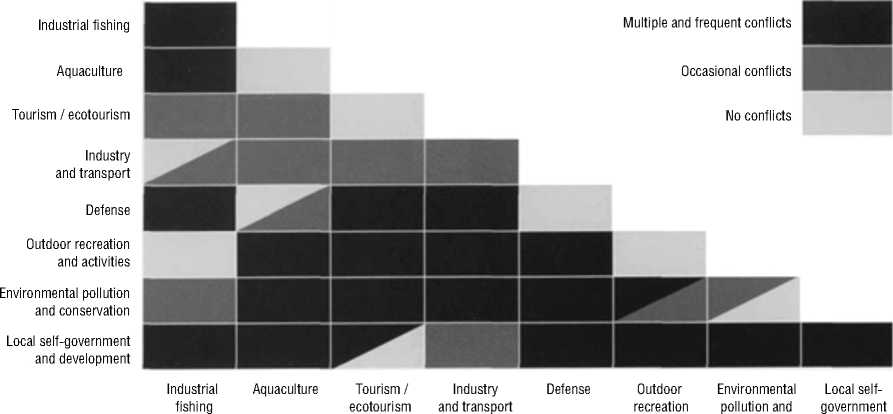
and activities conservation and development
nistrative-territorial spheres of knowledge [5]. The coastal zones, where the land falls within the jurisdiction of the RF subjects and the marine areas – within that of the federal authorities (the centre), are a bright example of such contradictions. That is why it is not quite clear how the strategic issues remaining the responsibility of the Ministry of Economic Development, and the issues entrusted to local authorities can be combined. Taking into account the current legislation, the integration of coastal territories and marine areas in the framework of the general object of state management, as stipulated by the Marine Activity
Development Strategy, is possible only with the introduction of significant amendments into a number of federal laws.
After resolving these issues of principle, it is necessary to collect the source data for evaluating the resource potential and risks in the coastal zone, for example in the above-mentioned rural locality of Teriberka. And only after that, it will be expedient to determine, which methods from the number of integrated strategic planning tools will prove to be appropriate for developing the coastal and marine component of the strategy.
Список литературы Comprehensive approach to arranging marine economy in the western arctic
- Aybulatov N.A., Vylegzhanin A.N., Mikhailichenko Yu.G. Nature management in the coastal zone of Russia’s seas. Bulletin of the Russian Academy of Sciences. Series: geography. 2005. No. 4. P. 13-26.
- Vasilyev A.M., Denisov A.M. Problems and prospects of complex approach to organization of maritime activity in coastal marine area of the Murmansk region. National interests: priorities and security. 2012. No. 24. P. 2-11.
- Voytolov sky G.K. Development dynamics. Theory and practice of maritime activities. Vol. 5. Moscow: SOPS, 2005.
- Denisov V.V. On the integrated management of the Barents sea resources (sea geographer’s view). Fish resources. 2004. No. 3 (8). P. 2-4.
- Denisov V.V. Environmental geography of multi-resourse shelves in the case of the Barents sea. Studies in oceanology, atmosphere physics, geography, ecology, water problems and geocryology. Moscow: GEOS, 2001. P. 94-98.
- Denisov V.V. Environmental and geographic framework of sustainable nature management in the shelf seas: (Ecological geography of the sea). Apatity: Publishing house of KSC RAS, 2002.
- Kotlyakov V.M. Geography in a changing world. Selected works in 6 volumes. Vol. 3. Moscow: Nauka, 2001.
- Development of integrated technologies for ensuring the economic activity of the shelves in the coastal areas of the Arctic and Southern seas: R&D report. Part 2: 2007-5-1.5-12-0. Murmansk Marine Biological Institute of the Kola science centre of the Russian Academy of Sciences; scientific supervisor. I.I. Matishov. Murmansk: MMBI KSC RAS, 2007.
- Marine Activity Development Strategy of the Russian Federation up to 2030 ((approved by the RF Government Order dated December 8, 2010 No. 2205-r) Legislation Bulletin of the Russian Federation. 2010. No. 51. Article 6954.
- Tarkhanova L.B. Tools for the strategic planning of marine activities in the conditions of uncertainty. Arctic: society and economy. 2010. No. 4. P. 101-108.
- Cicin-Sain B., Knecht R.W. Integrated coastal and ocean management: concepts and practices. Washington, DC: Island Press, 1998.
- Colby M.E. Environmental management in development: the evolution of paradigms Ecol. Econ. 1-991. Vol. 3. P. 193-213.
- The Future of the Coastal Planet Secretarial Norut Gruppen AS. Tromso, 1995.

